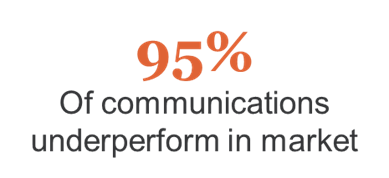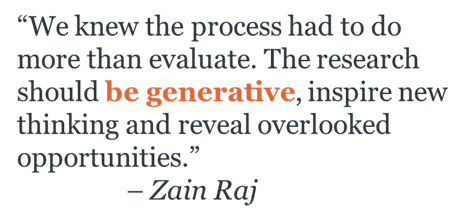
Did you realize as many as 95% of campaigns underperform in the marketplace. That says something about modern marketing, but it may say even more about the state of today’s communication research and evaluation methods. How could that many pieces of communication get past market research evaluation and still turn out so poorly?
One of the biggest reasons is the traditional approach to comms testing rests on generic metrics and KPIs. Moreover, traditional communication testing methods were designed primarily to serve suppliers, offering ease and replicability of their ‘product’ at the expense of providing context-rich insights for your brand. While these methods may give a ‘grade’ to the communications piece, they do little to guide optimization – you are left making some tweaks and hoping it works. (Because, of course, who has time for another round of testing).
 This is why, at Shapiro+Raj, we reimagined comm testing to not just provide evaluation of comms but also add a generative element to deliver real-world insights that inspire amplified activation. This means our clients not only know how the piece performs, but also how and why it could be optimized to better further their strategy, fit in the larger cultural and competitive context, and drive in-market behavior.
This is why, at Shapiro+Raj, we reimagined comm testing to not just provide evaluation of comms but also add a generative element to deliver real-world insights that inspire amplified activation. This means our clients not only know how the piece performs, but also how and why it could be optimized to better further their strategy, fit in the larger cultural and competitive context, and drive in-market behavior.
And did we mention with our approach you can get insight-driven, validated feedback on those optimizations you discover, instantly through the power of AI.
Our approach is grounded in four fundamental differences from traditional methods:
1.) Measuring Generic KPIs → Strategy-Forward Rubric
We’ve all been there, a comms evaluation report comes back and there are scores for ‘KPIs’ like memorability, motivation, etc. but the team is unsure on the big picture ‘so what?’. Which scores are most important? And more importantly, is the communication successful or not? The failure here is two-fold: 1) the definition of success was never defined; and 2) the metrics to measure success were not designed with that goal in mind.
At the heart of our approach is strategy alignment. Rather than relying solely on generic KPIs, we collectively define your strategic goals based on three critical dimensions:
- Belief: What belief is the concept trying to instill or shift?
- Behavior: What behavior should the concept inspire?
- Brand: How is the brand intended to be perceived or positioned?
2.) Isolated Analysis → Cultural & Competitive Context
A major goal of communications is differentiation. Yet, most communication evaluation is done in a vacuum. Sure, respondents may be asked how unique or different they feel the creative / message is, but is that really enough? We don’t think so. Instead, we leave the research ‘bubble’ and actively bring in relevant cultural and competitive context.
We begin our initiative with semiotics analysis to decipher the meanings embedded within your category using signs, symbols, and codes.
What communication codes drive the category?
Where is the whitespace for your brand?
What meaning does your imagery and lexicon hold against a broader cultural backdrop?
This analysis grounds us in the context so that we know where the category is crowded, and whitespaces exist. Meaning as we hear from respondents, we can place insights against this context, allowing us to truly understand how the communication will stack up in terms of differentiation and beyond.
3.) Rational Response → Rigorous Social Science
Humans process information through both system 1 (intuitive) and system 2 (rational). Yet too often researchers only capture rational, logical responses to communications, while missing the implicit and unconscious responses that fuel deep brand perceptions and incite action.
To go beyond the rational, we draw upon behavioral and social sciences. Our rigorous evaluation framework taps into both System 1 and 2 thinking, moving beyond rational reasoning into the rich realm of emotions, memories, and biases. We lean into techniques such as somatic pulse scaling, implicit association testing, vetted social science frameworks and proven projective techniques. The result is a multi-dimensional view of a concept’s potential impact on your target audience.
4.) Guess + Hope Optimizations → Agile, AI-Powered On-Demand Feedback
And finally, too many initiatives end with a list of optimization needs but no way of knowing if the optimization we craft will work. The respondents have come and gone so we just must guess and hope. Not anymore.
Through the power of AI, we can bring those respondents back to the table – instantly. These are not the generic synthetic respondents you may have heard of. Instead, we carefully train our AI on each interview transcript to provide an authentic representation of your audience. With this training in place, we can engage the GenAI to powerfully predict the audience’s reaction to the changes we’ve made. You get feedback in your audience’s words, in their voice. It’s like having another entire round of research without any of the hassle.
So why settle for subpar comms evaluations that leave you wanting more? Our approach raises the bar – delving deeper to understand how communications work with your strategy, with the competition and culture, and in the real world. This means your team has insights that can truly shape your brand’s future. If you’re looking to take your communications testing to the next level, please reach out to us today at communications@shapiroraj.com to learn more!
About Shapiro+Raj
Shapiro+Raj, the sixth-largest independent insights company in North America, generates Future-Forward Insights for Fortune 500 clients. Recognized as the top-5 most innovative research company, the #1 strategic insights consultancy, and the largest Nationally Certified Minority Business Enterprise, Shapiro+Raj operates from Chicago, New York, and Pune, India, serving global clients. For more information, contact Shapiro+Raj at (312) 965-2319 or visit https://www.shapiroraj.com.


